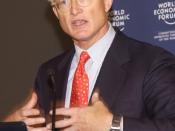In his book, The Competitive Advantage of Nations, 1990. Michael Porter argues that there are inherent reasons why some nations are more competitive than others; and why some industries within nations more competitive than others. The framework he uses for this has become known as 'Porter's diamond' (See Figure). Porter used it to illustrate the determinants of national competitive advantage.
Porter argues that the strategy of companies that have gain competitive advantage against the world best competitors through acts of innovation and upgrading it. Nation's competitiveness depends on the capacity of its industries to innovate and upgrade. Ultimately, nations succeed in particular industry because their home base environment is forward-looking, dynamic and challenge.
Defination
Competitiveness :The ability of a nation's industry to command high prices in foreign markets. And the aim is to support high wages and command premium prices in international markets. Competitiveness reflects standard of living which depends upon long run productivity growth in specific industries and segments.
Competitive advantage is achieved by lower costs or differentiation and sustained by quality and efficiency.
Industry's competitiveness comes from firm's competitiveness. Firm become competitiveness through innovation. Four determinants and two influences (see following graph) of national competitive advantage must be understood by managers in firms, otherwise industrial development bodies cannot operate effectively. Next let's discuss the theory in reference of Japanese Fax industry.
The Determinants of National Advantage
1. Factor Conditions
Factor conditions refer to the nation's position in factors of production, such as knowledge, capital, HR and infrastructure. These provide initial advantages which are subsequently built upon to yield more advanced factors of competition.
The inherited factors, such as land, labor, capital, are passively inherited, easily created or replicated, unskilled, play a role but in advanced economies, it is created factor that count, such as skilled human...


